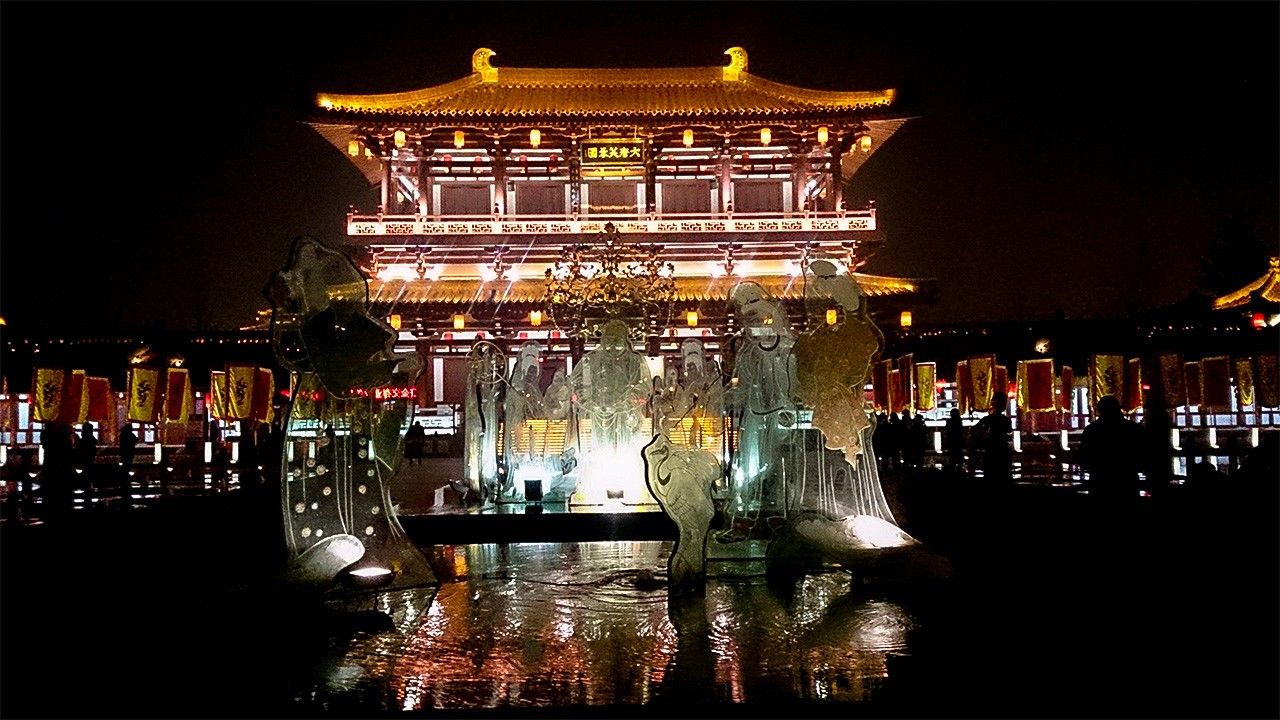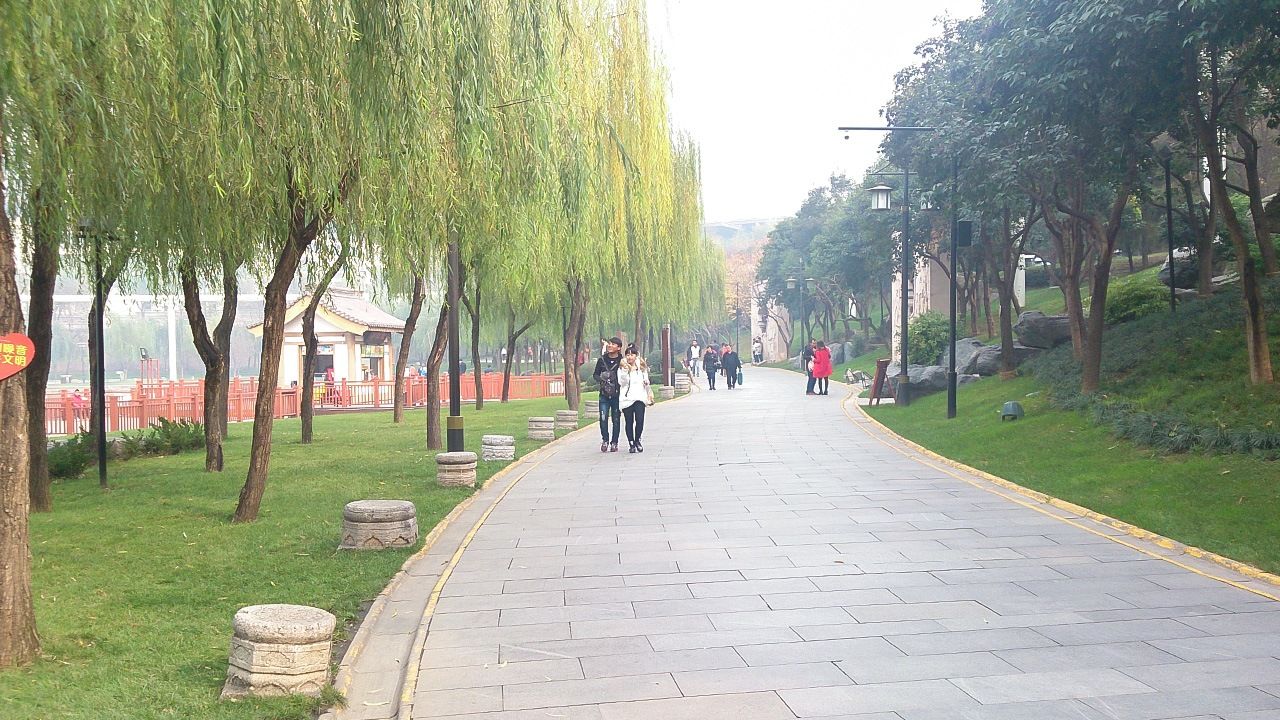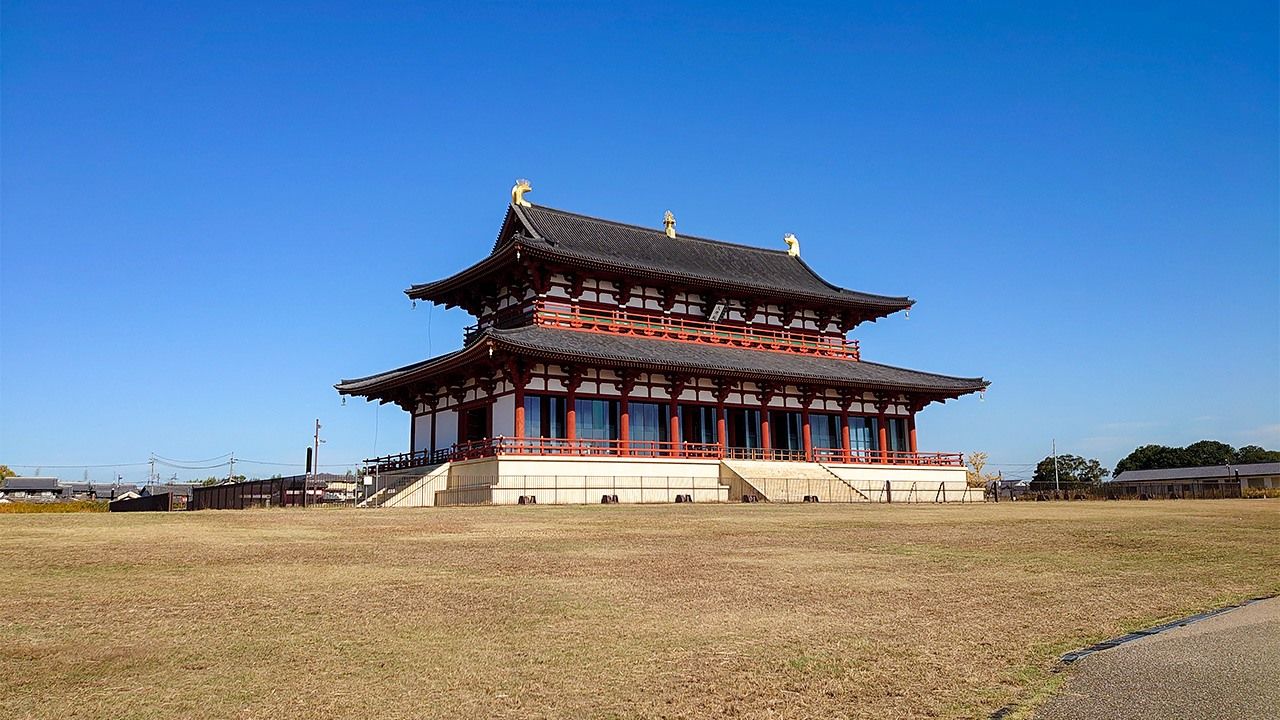
Ancient Dreams of Glory in the Wilderness: Heijōkyō and Chang’an
History Travel- English
- 日本語
- 简体字
- 繁體字
- Français
- Español
- العربية
- Русский
Pole Star of the Mortal Realm
The train sways and clatters on its tracks. Outside the window, trees dot the sparse yellow plain. A sea of white Chinese silvergrass spreads over the plain, and a towering red Chinese-style gate flashes into view, then disappears just as quickly.
That is the view from trains on the Kintetsu Nara Line between Yamato-Saidaiji and Shin-Ōmiya stations. That stretch of track crosses through almost the exact center of the former site of Heijōkyō, Japan’s Nara Period (710–794) imperial capital. The red gate is a restoration of the Suzakumon, the palace’s southern gate.
I visited the remains of Heijōkyō on a clear day in the middle of November 2020. I had visited Nara twice before, but had only frolicked with the deer in Nara Park. I had never been to Heijōkyō.
The day I visited was hot and distinctly not autumnal at all. The huge white sun climbed into a clear blue sky, coaxing a steamy mist from the wilted wilderness spreading out in front of me. The grassy plain spreads out as far as the eye can see, and standing there, somehow lonely, is a magnificent building with white cornerstones and stairs, vermilion columns, and a black roof with golden ornamentation. If you did not know that this was where an imperial palace once stood, you would think it utterly out of place.
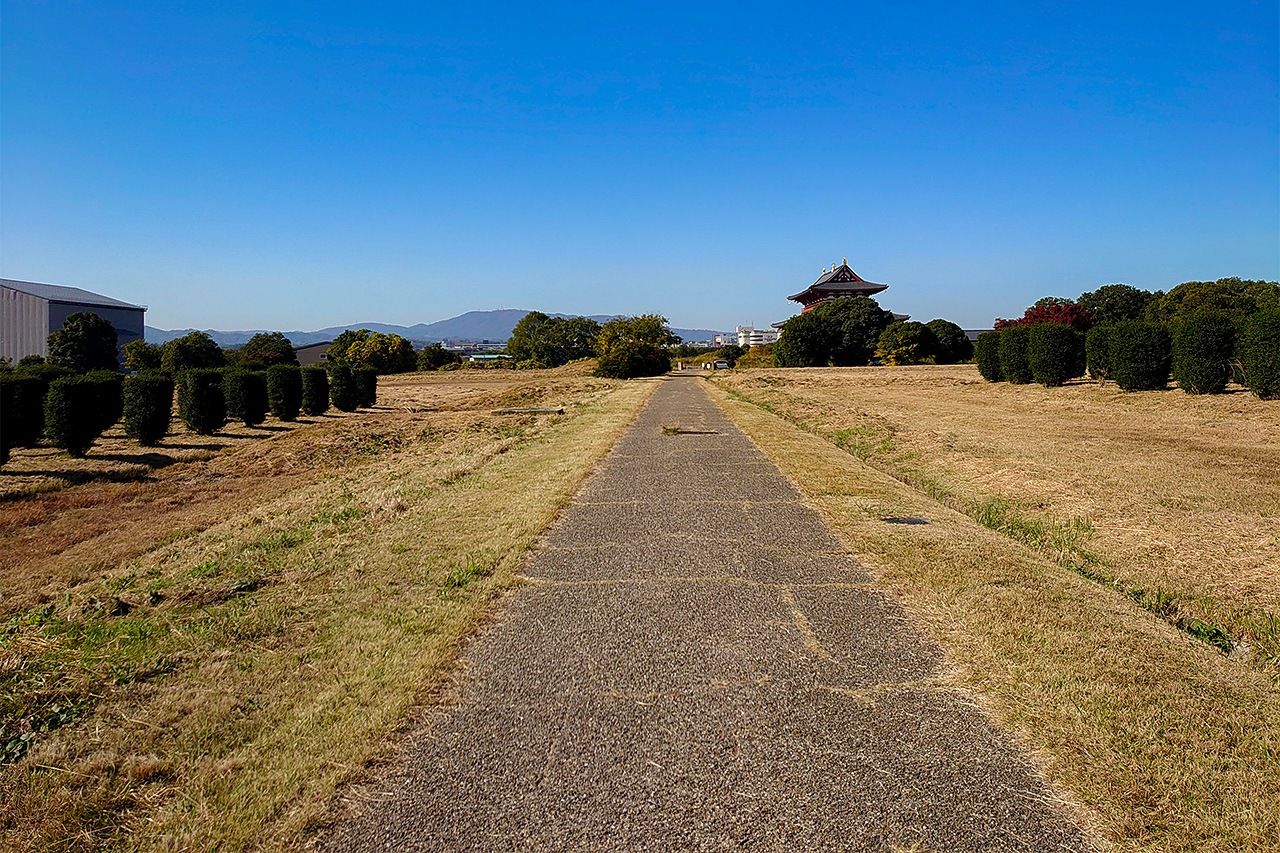
The remains of Heijō Palace, now gone to wilderness.
The buildings are a reconstruction of Daigokuden, which was the main hall of the Imperial Court and the central building of the capital. This was where important national celebrations occurred, like the ascension of the emperor, or the morning celebration on the first day of the New Year. The characters used in the name Daigoku are adapted from the Chinese characters for taiji, the “supreme ultimate oneness.” Taiji describes the state of existence before the origin of the universe, when yin and yang, pure and unclean, were all mixed in a state of chaos. In Chinese origin myths, the pure yang rose upward to become the heavens, while the unclean yin sank to become the earth, and that is how heaven and earth divided.
In other words, taiji is the origin of the heavens and the earth, of all things. If we apply this thinking to political philosophy, then taiji equates to the pole star, the center of the universe. If we further consider that the pole star is where the celestial emperor—the supreme ruler of the heavens—resides, then taiji is also an appropriate name for the ruler of the mortal realm. In ancient China, it was not unusual for the main palace of the emperor to be named Taijidian or Taijigong. This building, then, the Taijidian in Chinese, or Daigokuden in Japanese, became the pole star of the mortal realm.
In 708, Empress Genmei issued the Imperial Writ to Relocate the Capital to Heijō, and the move was completed two years later. Behind that decision lay the empress’s desire to reform Japan as a nation built on a codified legal system, which itself was based on the Chinese system, called ritsuryō, and to demonstrate that fact to other countries. The enactment and enforcement of the Taihō ritsuryō legal code in 701 meant that Japan was officially a nation with a legitimate legal code. When the emperor sent an envoy to Tang Dynasty China to announce that fact, the returning envoy reported that Chang’an was laid out entirely differently from Japan’s capital at Fujiwara. The palace at Chang’an was located at the northern edge, while the palace at Fujiwarakyō was found almost directly in the center of the city.
Reverence for the North
There was a proper ideological grounding for Chang’an’s layout. In the traditional Chinese view of orientation and direction, north is given particular reverence. As I mentioned, the northern pole star is considered the home of the celestial emperor. There was a saying, kunshi nan mensu, or “the great man faces south.” This implies that a ruler sits in the north, and faces all of his subjects in the south. In contrast, the ruler’s subjects are found in the south and prostrate themselves facing the ruler in the north. I imagine this has some connection to sunlight. Buildings facing south tend to get lots of sunlight, and can keep out cold north winds. Since “facing south” thus implies the illumination of yang, it confers good omens to do so, and can also imply access to “the light of justice” or “enlightenment.”
In addition, the emperor was considered to be the human embodiment of a dragon. Dragons love water, and according to wuxing, the interaction of the five elements in Chinese philosophy, water corresponds to north. That means that the emperor should be in the north, and face south. In the Chinese cultural sphere, many buildings are still built facing south. By the way, between east and west, east is considered better than west, since that is where the sun rises. This is also why the crown prince is referred to metaphorically as Tōgū, or “eastern palace.”
From our modern viewpoint, we might think this is all just superstition, unworthy of much attention. However, just as in the pre-Enlightenment West, when the Christian spiritual worldview held supremacy, East Asia at the time was also under the influence of a spiritual worldview. In such times, humans wanting to govern other humans often need to rely on explanations that transcend the mundane. For example, in Japan the emperor’s rule was justified by identifying him as the “son of heaven,” and tracing his lineage back to the goddess Amaterasu. In such a system, we cannot simply ignore things like feng shui or cosmology, because if we roll our eyes at ideas that surpass mundane human knowledge, we actually strike at the foundation of governance itself.
Tang China’s cosmology, including that view of directions, as well as its city planning, was the most advanced in East Asia at the time. It makes sense that Japan, as a relatively unsophisticated nation, would be eager to mimic it.
That also had practical benefits. Copying the layout of Chang’an in its own capital would help Japan earn recognition as a sovereign state of its own, which would also discourage foreign attack. In other words, earning that international recognition was a question of ensuring a future for the nation. When a highly developed country has an advanced culture or trend of thought that serves as a stable basis for government, placing that nation in a position of prominence with benefits like economic prosperity, then it’s only natural for other nations to actively follow suit. That is as true now as it was in those ancient days. Things like democracy, capitalism, and the Olympics are all modern examples of the same idea.
Chang’an in Miniature
When Japan moved its capital to Heijō, creating a new pole star for its nation, it succeeded in creating a miniature version of Chang’an with Heijōkyō and Heijō palace. This place, once the nation’s guiding light, has become a prairie wilderness in the past 1,300 years. Not even a ruin. Just wilderness. There is a historical park, with tended trees and paved sidewalks, but there is no sign of the capital’s glory days, of the magnificent palaces that must have been here, or of the lives of the noble inhabitants. All has been swallowed by the soil, and not even a trace remains. As I walked around the former location of the palace, thinking back on all the stories that might have happened here so long ago, a memory came to me, like déjà vu.
It was a memory of walking on the site of the Daming Palace in Xi’an. Xi’an was once, long ago, Chang’an. The Tang capital of Chang’an was home to three palaces: Taiji, Daming, and Xingquing. Daming was the largest. With an area of 3.11 square kilometers, it was the first or second largest palace in China’s history, larger than the current Imperial Palace in Japan including the outer garden (2.3 square kilometers), and four times larger than the Forbidden City in Beijing (0.72 square kilometers).
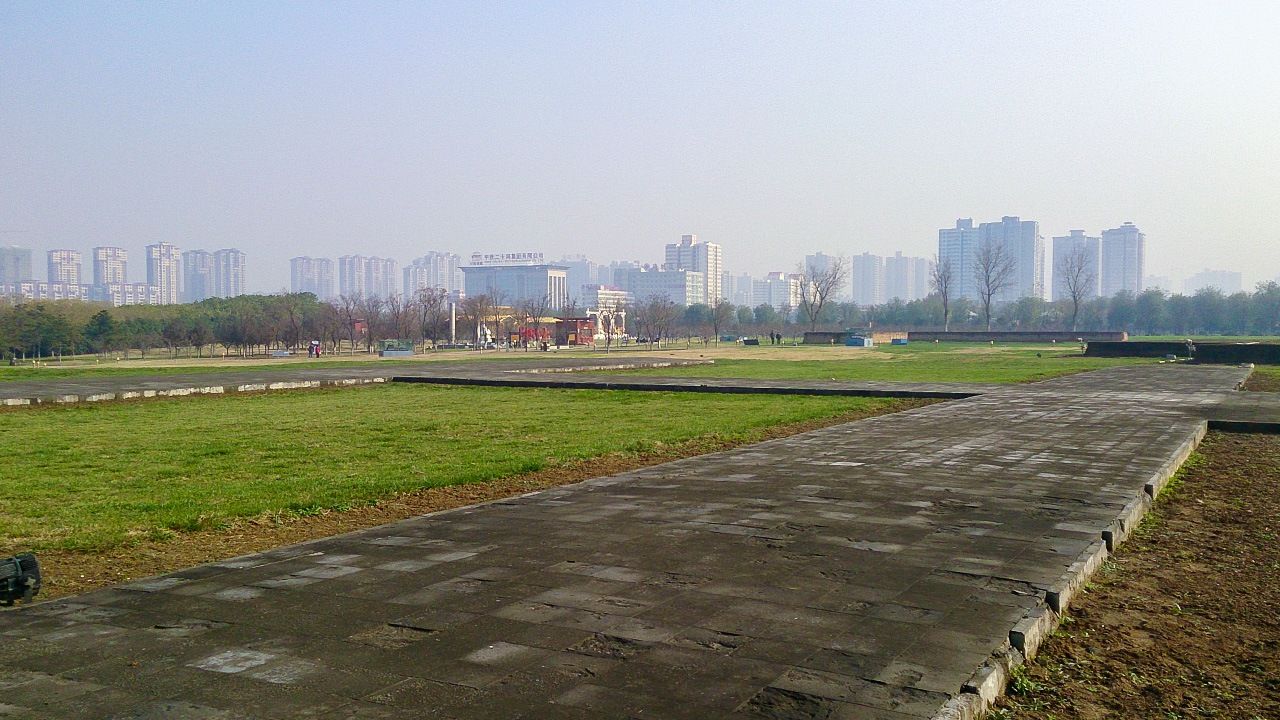
The former location of Daming Palace.
Originally, Daming was intended only to serve as a summer palace, while Taijidian in northern Chang’an was the primary palace, but Taijidian had some issues. Basically, when Chang’an was laid out, the city planners forced everything to conform to that cosmology discussed above, so it had to be in the north of the city. However, that area is a lowland, so in summer it becomes exceedingly humid and damp. Emperor Gaozong of Tang (628–683) suffered from chronic illness which made the Taiji Palace environment unbearable, so in 662 he had Daming expanded and improved to serve as his new residence.
It took the work of tens of thousands of people, and enormous investment, to build Daming. The salaries of all bureaucrats working in Chang’an were cut by one month to help cover the construction costs. The resulting palace, one of the largest in history, flourished as the Tang Dynasty’s political and cultural center for more than 230 years. It was the symbol of the Tang Empire, the most prosperous in the world in the seventh and eighth centuries. It drew envoys from all over Asia, including Japan. It was there that where Wu Zetian (624–705), the only female emperor in Chinese history, ascended to the throne, and where Emperor Xuanzong of Tang (685–762) and Yang Guifei (719–756) pledged their love to each other.
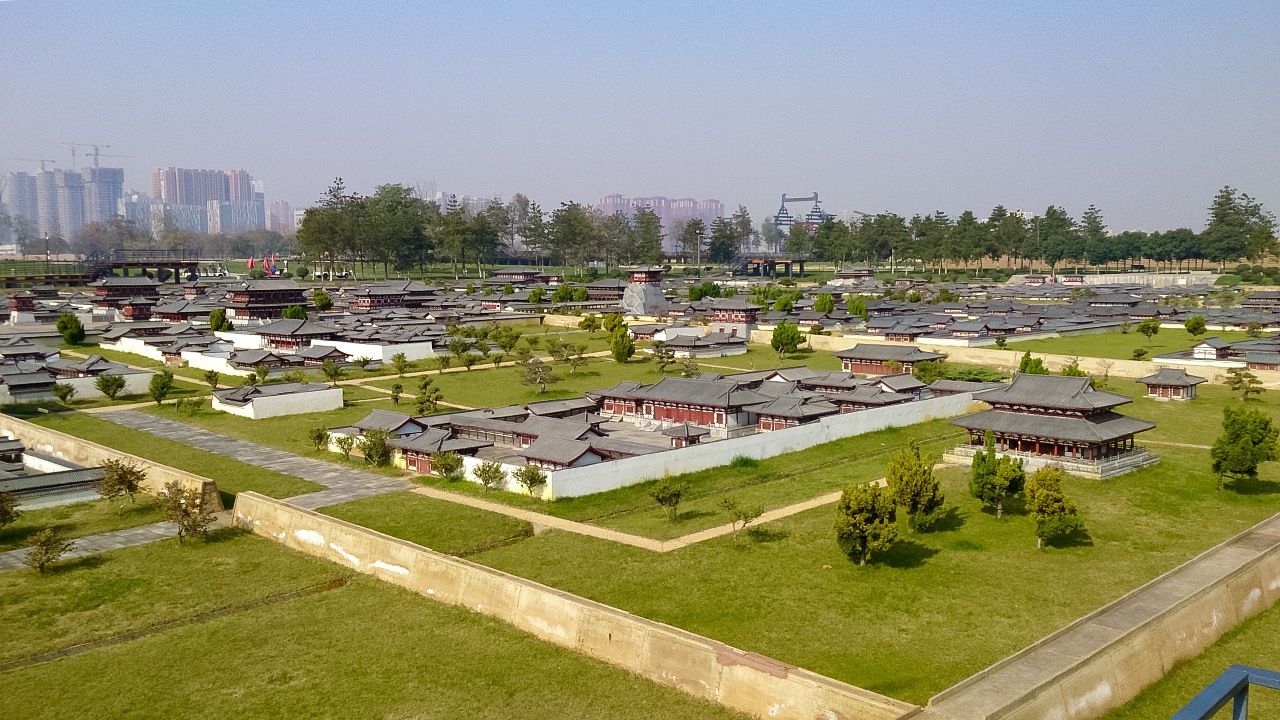
This 1/15 scale model of Daming palace offers a glimpse of past glory.
Ancient Dreams Buried in the Wilderness
A war at the close of the Tang Dynasty resulted in the Daming Palace burning to the ground and being left in ruins. A thousand years of weather turned the location into wilderness, and for a time the city ruins became a shelter for poor commoners. It was eventually outfitted as a historical park in 2010, and officials planted trees, built paved walkways, and put up information signs. Some buildings were also replicated. Even so, there remains no trace of the original palace. The ancient dreams of power and luxury that gave it shape are buried in the dark earth beneath that wilderness, finding shape only in the musings of visitors. Walking around both sites, Heijōkyō and Chang’an, offers a similar sense of desolation. I find myself wishing I had access to Doraemon’s taimu beruto—a belt that lets the wearer travel through time and space.
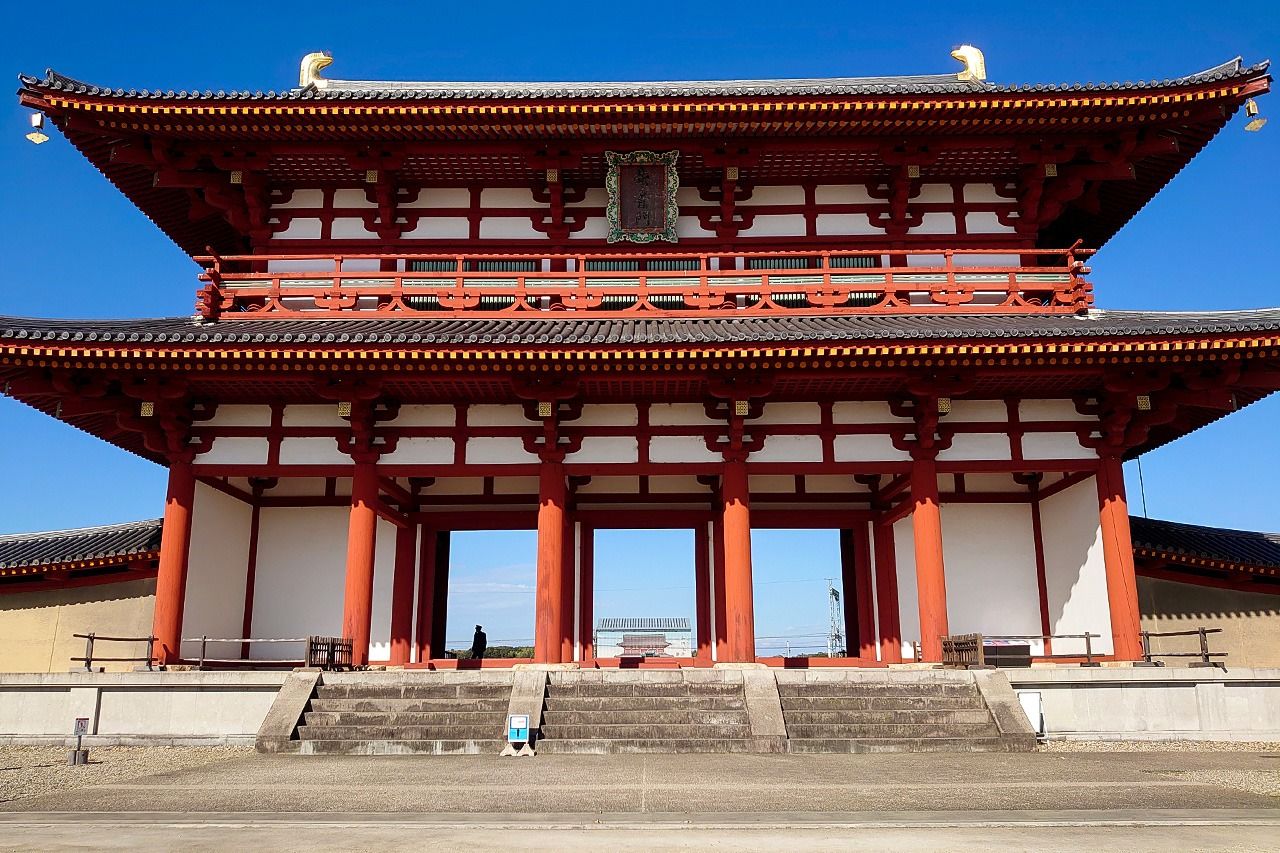
The view from in front of Suzakumon gate of old Heijō palace.
Heijōkyō, which was modeled on Chang’an, really did manage to capture its character. The streets are laid out in a grid pattern built around the main road of Suzakuōji running north-south, with the palace in the center of the northern part of the city and its main gate Suzakumon facing south. There were also two marketplaces, east and west: Higashiichi and Nishiichi. Both cities also had a small lake in the southeast corner. However, while Chang’an was almost a perfect rectangle, Heijōkyō had a large projection to the northeast. Heijōkyō is also half the length and width of Chang’an, with about a quarter of the area. The Suzakuōji leading south from the palace in Chang’an is 150 meters wide, while the same road in in Heijōkyō is only about 74 meters wide, almost exactly half the original once more. I heard that Japan today has three roads that are 100 meters wide, but not any at all that are 150. The central thoroughfare in Chang’an is more of a plaza than a road, actually.
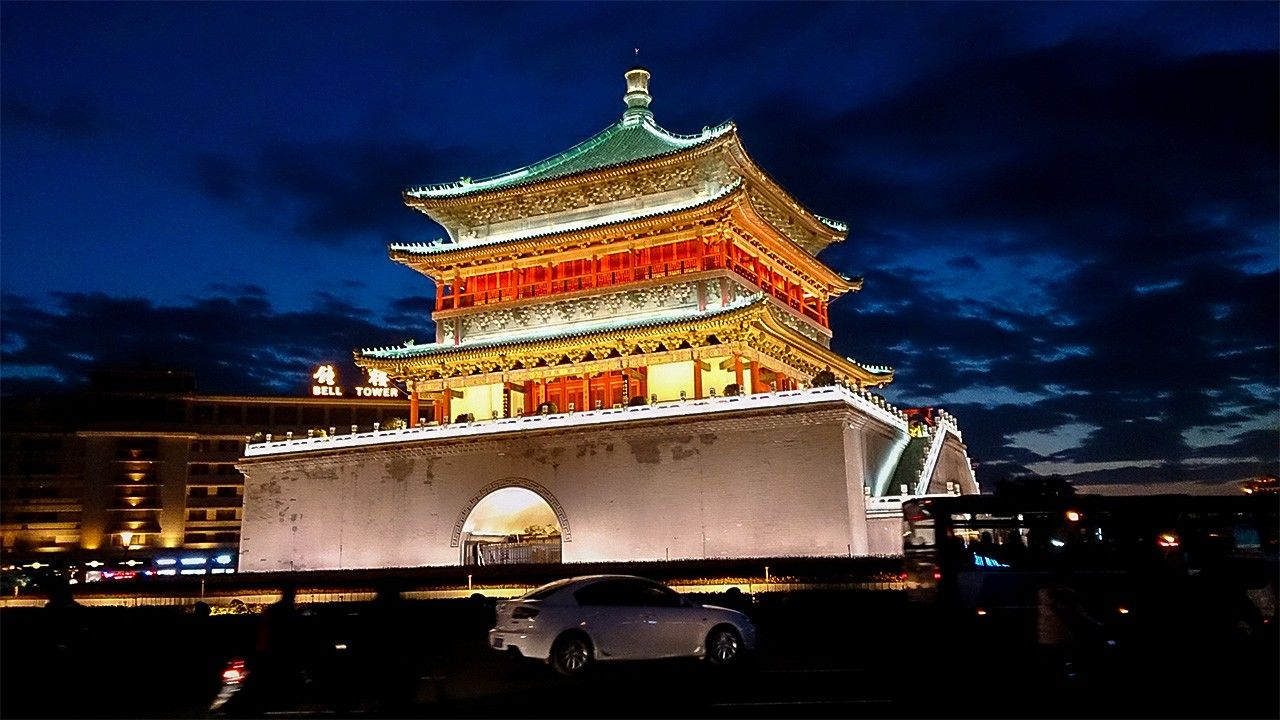
The bell tower in the center of present-day Xi’an’s old town. The belltower served as a landmark for orientation.
As for the water bodies in the southeast of each city, the one in Chang’an was called Qujiang Lake, while Heijōkyō’s was Koshida Pond (today Gotoku Reservoir). Qujiang was considered one of Tang China’s most famous sights, surrounded by incredible scenery including a beautiful imperial garden. It was a popular destination among the nobility, and students who had passed the imperial examination for civil service also commonly invited friends here for parties. There was even a popular drinking game called Qujiang Float Drinking, where a cup filled with liquor was floated on the water, and when it stopped in front of someone, that person had to drain the cup. The game was a famous sight in Chang’an, and was mentioned in poetry as well.
When the Tang Dynasty fell, Qujiang fell into disuse as well, and it has simply dried up in the thousand years since. Modern Xi’an has Qujiangchi Ruins Park, which was built in 2007, but it is simply a park built on the old site. The Tang Paradise theme park is also nearby, but the Chinese name—Datang Furong Yuan—does not mention Qujiang. That’s because a Sui Dynasty emperor disliked the character for Qu, meaning “bent,” so he changed the name Qujiang to Furong, the Chinese name for the cotton rose.
Sadly, Koshida, in the southeast of Heijōkyō, was apparently not as beloved as Qujiang. Heijōkyō was only the capital for around 70 years, and while Japan did adopt many Chinese systems, for some reason it avoided the imperial examination system (and the official eunuch system, too). Still, walking around the former Heijō palace grounds, I cannot help but be reminded of the scenery at Qujiangchi Ruins Park.
Heading south from Daigokuden along the central path, the railroad tracks run buried in a sea of wind-swept silvergrass. After crossing the tracks, the rebuilt Suzakumon gate stands in front of you. It brought to mind the scene I’d seen from the train window on the Kintetsu Nara Line. It also made me wonder what a railroad is doing running through the center of the former Heijō palace, a nationally designated historical site and registered World Heritage Site. Isn’t it awfully unseemly for a railroad to run through the site of a former imperial palace, the very face of the ancient nation?
It appears that this section of track was laid before anyone started excavating the palace ruins, so there wasn’t anything anyone could do about it once the ruins were revealed. Still, there is some talk of shifting the tracks to avoid the old palace grounds. Construction estimates put completion sometime in 2060. Once it is done, the unique experience of taking a train through the ruins, with a view of the restored palace gate from the windows, will end. The year 2060 is still almost 40 years away. Even trying to imagine what I’ll be doing then makes me dizzy.
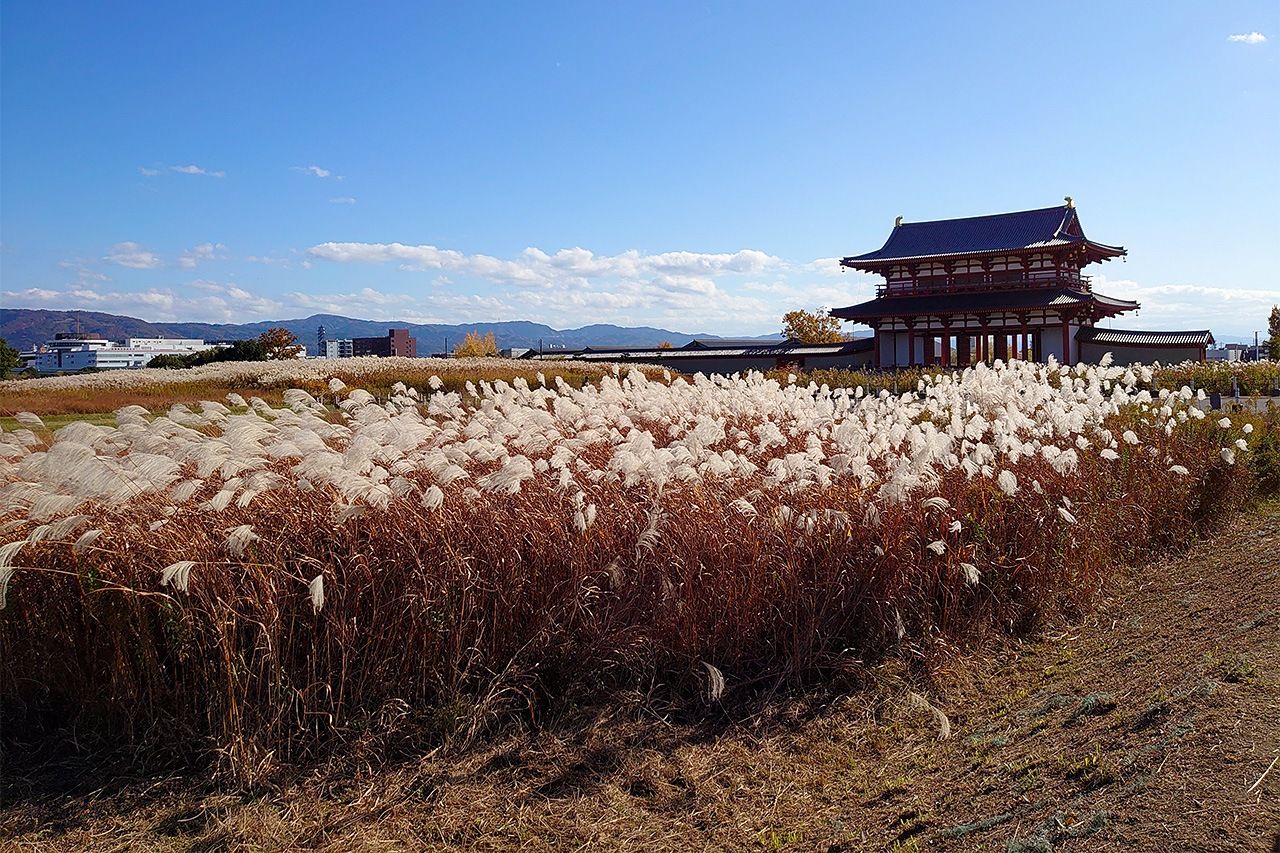
Suzakumon gate standing in the silvergrass.
(Originally published in Japanese. Banner photo: The reconstruction of the Heijō palace’s main hall, Daigokuden, stands now in wilderness. All photos © Li Kotomi.)
